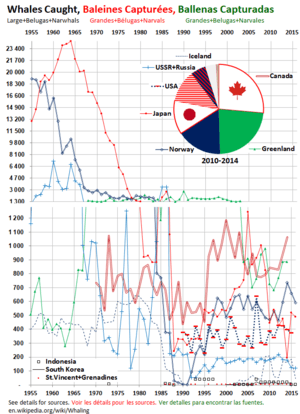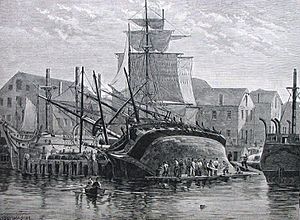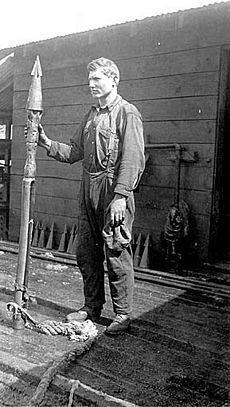Whaling in the United States facts for kids
Commercial whaling in the United States started in the 1600s in New England. This industry grew a lot between 1846 and 1852. The city of New Bedford, Massachusetts, sent out its last whaling ship in 1927. Whaling was important for making three main products: whale oil, spermaceti oil, and whalebone.
Whale oil was made by heating whale blubber (fat). It was used to lubricate machines during the Industrial Revolution. This was before people found out how to use oil from the ground. After getting the blubber and spermaceti, most of the whale was thrown away.
Spermaceti oil came only from the head of sperm whales. It was more expensive than regular whale oil. People loved it for lighting lamps and making special candles. These candles burned very cleanly. Spermaceti is actually more like a wax than an oil.
Whalebone came from the baleen plates in the mouths of baleen whales. It was used to make things that needed to be light but strong and thin. For example, it was used in women's corsets, umbrella ribs, and even buggy whips. For almost 100 years, products from New England whaling were a big part of the American economy.
Long before Europeans arrived, Aboriginal whaling was practiced by Native Americans in what is now the United States. Today, some Native American groups can still hunt whales for cultural reasons. This is allowed by the International Whaling Commission. Their catches have increased over the years. The U.S. government also has its own bans against whaling.
Contents
History of Whaling
Early Whaling in New England
Commercial whaling in the U.S. likely began around the 1650s. English settlers and the Shinnecock Indians on Long Island made agreements to hunt whales. Before this, they would chase small whales onto beaches to catch them. Nantucket joined in 1690. They asked Ichabod Padduck to teach them how to hunt whales.
On Nantucket, the island's south side was divided into sections. Each section had a tall mast to look for whale spouts. Five men worked in each section, with one watching from the mast. When a whale was seen, small boats were rowed from the shore. If a whale was caught, it was brought ashore. Its blubber was cut off and boiled in large pots called "try pots" to make whale oil. Even when Nantucket ships went further out to sea, they still came back to shore to boil the blubber.
By 1715, Nantucket had six ships hunting whales. By 1730, they had 25 ships. Each ship had 12 to 13 men, and about half of them were Native Americans. Sometimes, almost the entire crew, except the captain, was Native American. By 1732, New England whalers reached the Davis Strait between Greenland and Baffin Island. Whaling slowly spread. By the 19th century, whaling became a huge industry.
Whaling Grows Big
Whaling grew a lot starting in 1768. It reached its peak just before the American Revolutionary War. Between 1771 and 1775, ports in Massachusetts alone used many ships for whaling. The American Revolution and other wars stopped the industry for a while. But after the American Revolution, whaling grew even more.
The first New England whalers sailed around Cape Horn in 1791. They entered the Pacific Ocean to hunt sperm whales. At first, they only hunted off the coast of Chile. But by 1792, they reached Peru. In 1818, George W. Gardner found new hunting areas far out at sea. In 1820, the first New England whaling ship, the Maro, hunted sperm whales near Japan. Whalers also started visiting the Hawaiian Islands to get fresh food and more crew, and to fix their ships.
In 1829, the New England whaling fleet had 203 ships. In just five years, it more than doubled to 421 ships. By 1840, there were 552 ships. The most ships were seen in 1846, with 736 American whaling vessels. From 1846 to 1851, about 638 ships were active. Most came from New Bedford, Nantucket, New London, Connecticut, and Sag Harbor. New Bedford had the most ships.
In 1848, Thomas Welcome Roys sailed through the Bering Strait. He found many "new" whales, which were bowhead whales. The next year, 50 whaling ships went to the Bering Strait because of his discovery. The peak for whales caught was in 1852, when 220 ships caught 2,682 bowheads. Catches then went down, and the fleet moved to the Sea of Okhotsk.
The Peak of Whaling
The American whaling fleet was largest in 1858, with 199,000 tons of ships. Just two years later, in 1860, the fleet had shrunk. The American Civil War also hurt whaling. After the war, fewer ships returned to sea. By 1876, only 39 American ships were hunting whales.
Some ships would go to the lagoons of Baja California in winter. This was a very busy time for whaling there, known as the "bonanza period," starting in 1855. Whaling boats would crisscross the lagoons, chasing whales. But less than twenty years later, in 1874, whaling in these lagoons stopped because there were not enough whales.
Many New England ships were lost in the 1860s and 1870s. During the Civil War, Confederate ships like the CSS Shenandoah captured or burned 46 whaling ships. The United States bought 40 old whaling ships to sink them in harbors like Charleston to block them. This was called the Stone Fleet. In 1871, 33 whaling ships were lost in the Arctic near Point Belcher. Another 12 ships were lost in 1876.
The use of steam-powered ships and high prices for whalebone made San Francisco a major whaling port in the 1880s. By 1893, it had 33 whaling ships, with 22 of them being steamers. At first, these steamships only sailed in summer. But when bowhead whales were found near the Mackenzie River Delta in 1888–1889, ships started to spend the winter at Herschel Island.
The first ships wintered at Herschel Island in 1890–1891. By 1894–1895, fifteen ships were staying there. At its busiest, from 1894–1896, about 1,000 people lived on the island. This included different groups of Inuit people, Native American caribou hunters, and whaling crews.
Ships continued to winter at Herschel Island into the 1900s. But by then, they focused more on trading with native people than on whaling. By 1909, only three whaling ships were left in the Arctic fleet. The last bowhead whale was caught for commercial reasons in 1921.
The End of Whaling
Whaling in New England declined because of the Industrial Revolution in the mid-1800s. New fluids like coal oil and turpentine became available. By 1895, the New England whaling fleet had only 51 ships. Only four ports regularly sent out ships: New Bedford, Provincetown, San Francisco, and Boston. Boston stopped whaling in 1903, and San Francisco stopped in 1921. Only New Bedford continued, sending out its last whaler, the John R. Mantra, in 1927.
Modern Whaling in the U.S.
Whaling stations also operated in Alaska and on the Canadian west coast. The American Pacific Whaling Company had ships and a plant in Washington state in 1912. They made good profits and built new ships. Another company, West Coast Whaling Company, started in 1912 in Trinidad, California.
While whaling ended on the east coast in the early 1900s, it continued for a short time on the west coast. A small whaling operation existed in San Francisco until the early 1970s. In the early 1960s, a small whaling business started near Astoria, Oregon. They sold whale meat to mink farms and whale oil to NASA. But as new synthetic oils were made, the need for whale oil decreased. This operation closed around 1965.
Federal Ban on Whaling
In 1971, the U.S. Congress passed the Pelly Amendment. This law made sure that people in the U.S. followed international whaling rules. In 1972, Congress passed the Marine Mammal Protection Act. This law made it illegal for anyone in the U.S. to kill, hunt, injure, or bother any marine mammals. Whales that are endangered are also protected by the 1973 Endangered Species Act. In 1979, another law extended the whaling ban to foreign ships within 200 miles of the U.S. coast.
Native Whaling Today
In Alaska, hunting bowhead whales and beluga whales is managed by the NMFS. In 2016, Alaskans caught 59 bowhead whales. They also caught a few minke and sperm whales, which were not allowed. The IWC does not count beluga whales. Alaskans caught 326 belugas in 2015. The number of belugas caught each year is usually between 300 and 500. Bowheads caught are between 40 and 70 per year.
The 1855 Treaty of Neah Bay allowed the Makah people in Washington State to hunt whales. They stopped in the 1920s because there were not enough whales. But whale numbers recovered by the 1980s. In 1996, the Makah asked the International Whaling Commission for a quota to hunt whales for food and cultural reasons. Some countries supported them, but others worried about setting a bad example. In 1997, the Makah argued that whaling was important for their culture. They received a quota. However, in 2001, the U.S. government made it illegal for the Makah to hunt whales again. The Makah, the U.S. government, and environmental groups are still in legal battles over this.
Life as a Whaler
There were different reasons why people became whalers. Some hoped to own their own whaling ship one day. Others were looking for adventure. And some were trying to escape problems on land. Most whalers only went on one trip. Only those who wanted a career in whaling went out more than once.
A whaler's pay depended on his "lay," which was his share of the catch. Sometimes, after a long trip, a sailor would get almost no money. He might even owe money to his employers. Even on a very successful trip, a regular crewman earned less than if he worked on a merchant ship. The "lay" system was a gamble. Sailors were not guaranteed good wages. One sailor earned only six cents after five months at sea. But sometimes, sailors got lucky and earned a lot of money after just a couple of trips. More often, they earned very little after years at sea. Ships that came back with little oil were called "broken voyages." Ships that came back full of oil were praised.
Going to sea was an adventure for young men. Especially when they visited beautiful places like the Sandwich Islands, Tahiti, or the Marquesas Islands. Many sailors, including the famous writer Herman Melville, would leave their ships in these places. After his adventures, Melville joined another whaler that took him to Hawaii. From there, he sailed home. The California Gold Rush also offered young men an adventure. Many whalers, even captains, left their ships in San Francisco to join the gold rush. This left many ships empty in the bay.
Scrimshaw Art
Many sailors on whaling ships in the 1800s created scrimshaw. Scrimshaw is a type of art made by drawing on whale teeth or other types of ivory. Sailors used knives or other sharp tools to carve images. Then, they would rub ink into the carvings to make the drawing stand out. Some sailors even used surgical tools for their scrimshaw. Besides whale teeth, they also used whale jawbones, walrus ivory, and elephant ivory. Most scrimshaw during the whaling era was made from whale parts.
Other scrimshaw items included tools like rope splicers, needles, and yarn holders. Sailors also made walking canes. Most scrimshaw was made between 1840 and 1860, which was the busiest time for the whaling industry. More than 95% of old scrimshaw pieces were made by artists whose names we don't know. Some famous scrimshaw artists include Frederick Myrick and Edward Burdett. They were among the first to sign and date their work. Many museums now have great collections of old scrimshaw. One of the best is the New Bedford Whaling Museum in Massachusetts.








